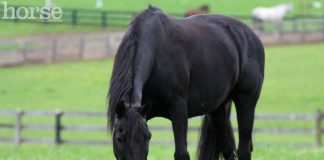
Q: My senior horse has Cushing’s disease. Can you recommend some optimal diet plans?
that sheds unevenly, horses with this malfunction of the pituitary gland often display muscle wasting along their toplines and hindquarters, yet they may have a potbelly appearance.
The goal in feeding a horse with Cushing’s, is to limit the intake of nonstructural carbohydrates (NSC) feeds, such as the sugars and starches found in grains. In many cases, feeds that are labeled as “senior” feeds are also high in NSC content and should be avoided when feeding a horse with Cushing’s disease.
The objective is to feed a diet that has less than 10 to 20 percent of total digestible energy (the combination of sugars and starch, or NSCs). High-fiber components, such as these found in hay, hay cubes, pasture, and beet pulp, should constitute the main portion of a senior horse’s diet. Most horses will eat between 1½ to 2 percent of their body weight per day in forage. (For example, a 1000-pound horse should be fed 15 to 20 pounds of hay per day.) It is important to recognize that some hays may contain high levels of NSC, depending on the species of grass and when and how it was harvested. Older horses often have dentition problems, too, so provide good quality hay and feed that is easy to chew.

In general, you’ll want to avoid all grain and/or feed with molasses, this includes eliminating treats, horse cookies and candies since they are high in sugars.
If more calories are needed to maintain body condition, then in addition to feeding good quality forage, substitute high-fat supplements (oil and/or stabilized rice bran) for grain.
A Cushing’s horse also benefits from the effects of medication like pergolide, which can reduce the clinical signs and secondary effects of the pituitary malfunction. This medication facilitates the horse’s best use of a Cushing’s “diet.”
Read more on Cushing’s Disease >>






very well written and informative, thank you!
cheese?
Great article
good article. we have a horse who might have cushings and this was very informitive.
fairly good but i have a cushings horse who is doing well i give perolite but i also give some blue seal beet pulp pellets i soak them, also chaste tree powder. i find she does well and during the winter i give bran and some flax seed ground up. i also use a farrier who does natural shoeing.
great advice
good tips
Where do you get the medicine? I need it right away. My guy isn’t doing well.
I had guessed my horse had cushings 2 years ago but the vet tested her blood and said she had lime dicease, and then she had lamanitist. I gave her her med with malasas. She was loosing weight like crazy and had diaria. So I told the vet and said I was going to put her on senior feed(has malasas). When I told him she still had diaria he came to see her and he said she had cushings. He never told me there was a diet restriction. Anyway, she still has diaria and I did change her diet because of you direction. What can I do to stop the diaria?
Very Helpful information. I was wondering about feeding apples or carrots as treats insread of the ones not recommended. Can anyone answer this question?
This article was very helpfull. My 25yr old horse was recently diagnosed with cushings.
By all that I have read with regard to apples and carrots should be feed very little of these as they have natural sugars. We have found that giving Chastetree Berrys has improved our 22 yr old Appy mare heaps.( We are in Australia so couldn’t put state.)
my horse has been diagnosed with cushing i find low sugar low starch diet like bailey lo cal provde all nutrition with hi fi lite to bulk up feed and ad lib soaked hay.he is now on meds pergolide so see how it helps heard good vibes about it .
Great, my 31 year old pony mare will benefit from some dietary changes. Her shaggy belly and coat over summer makes me suspect cushings and I will feed her accordingly and hopefully enjoy her company a little longer.
good article. My rescue horse was just diagnosed with cushings. He foundered, vet was called and she did a blood test for cushings. He is now on pergolide and new diet. no treats, neutrina safe-choice, beet pulp with no molasses. I am concerned about spring grass and would like to know if he will ever be out on pasture again? Can anyone answer this? Any ideas? Thanx
After nearly losing our 26 yo paint mare, she was put on pergolide, and now eats a diet of grass/grass hay, Banks Mill Low Starch and ADM Sta-Strong (both are pelleted feeds with little to no starches and sugars). I’m happy to say that even though she’ll never return to her ‘old’ self she’s back to galloping back to the stable yard for visits and, of course, dinner.
To all those wondering about treats there are low sugar/low carb commercial treats and my horse loves celery and lettuce as a treat so you can still give them goodies just not the sweet ones like carrots and apples.